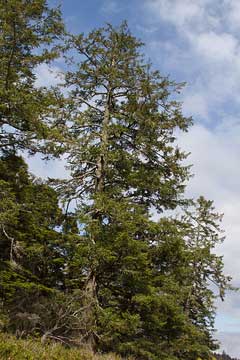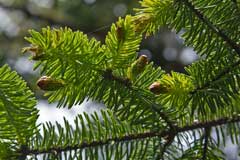 |
|
http://www.flickr.com/people/35034347371@N01 |
 |
| http://www.flickr.com/people/35034347371@N01 |
Translate this page:
Summary
Bloom Color: Red. Main Bloom Time: Late spring, Mid spring. Form: Pyramidal.
Physical Characteristics

 Picea sitchensis is an evergreen Tree growing to 50 m (164ft) by 10 m (32ft) at a fast rate.
Picea sitchensis is an evergreen Tree growing to 50 m (164ft) by 10 m (32ft) at a fast rate.
See above for USDA hardiness. It is hardy to UK zone 7 and is not frost tender. It is in leaf all year, in flower in May, and the seeds ripen from September to October. The species is monoecious (individual flowers are either male or female, but both sexes can be found on the same plant) and is pollinated by Wind.
Suitable for: light (sandy), medium (loamy) and heavy (clay) soils and can grow in nutritionally poor soil. Suitable pH: mildly acid and neutral soils and can grow in very acid soils.
It cannot grow in the shade. It prefers moist or wet soil. The plant can tolerate maritime exposure.
It cannot tolerate atmospheric pollution.
UK Hardiness Map
US Hardiness Map
Synonyms
P. menziesii. Abies menziesii. A. sitchensis. Pinus sitchensis.
Plant Habitats
Woodland Garden Canopy; Bog Garden;
Edible Uses
Edible Parts: Flowers Inner bark Seed Seedpod Shoots
Edible Uses: Condiment Gum Tea
Young shoots - raw[118, 256]. Young male catkins - raw or cooked. Used as a flavouring[172]. Immature female cones - cooked. The central portion, when roasted, is sweet and syrupy[172]. The cones are 6 - 10cm long[82]. Inner bark - raw or cooked[256]. It can be dried, ground into a powder and then used as a thickener in soups etc or added to cereals when making bread[172]. The inner bark was usually harvested in the spring, though it was also sometimes taken in the summer[256]. An emergency food, it is only used when all else fails. Seed - raw[172]. The seed is about 2 - 4mm long[229]. It is rich in fats and has a pleasant slightly resinous flavour but is too small and fiddly to be worthwhile unless you are desperate[172, K]. A refreshing tea, rich in vitamin C, can be made from the young shoot tips[172]. A gum obtained from the bark is hardened in cold water and then used for chewing[118, 177, 256]. It should be aged for 3 days or more before using it. The best gum is obtained from the southern side of the tree.
References More on Edible Uses
Medicinal Uses
Plants For A Future can not take any responsibility for any adverse effects from the use of plants. Always seek advice from a professional before using a plant medicinally.
Analgesic Antirheumatic Antiseptic Diuretic Laxative Ophthalmic Pectoral Poultice
Salve Stomachic TB Vitamin C
Sitka spruce was widely employed medicinally by several native North American Indian tribes who used it especially for its antiseptic and pectoral qualities in the treatment of lung complaints, wounds, sores etc[257]. It is little, if at all, used in modern herbalism. The inner bark is laxative[256, 257]. It has been chewed in the treatment of throat problems, coughs and colds[257]. A decoction of the branch tips and the bark has been used in the treatment of rheumatism, stomach pains, constipation and gonorrhoea[257]. A decoction of the cones has been taken in the treatment of pain[257]. The cones have also been used in steam baths to treat rheumatism[257]. A decoction of the bark has been used as a steam bath in the treatment of back aches[257]. The resin is antiseptic and diuretic[257]. A decoction has been used in the treatment of gonorrhoea[257]. A poultice of the resin has been used as a rub on rheumatic joints[257]. Combined with Indian Hellebore roots (Veratrum viride), it has been used as a poultice on rheumatic joints[257]. The resin has also been used as a dressing or poultice on cuts, broken skin, boils, wounds, infections and suppurating sores[257]. The resin has been chewed as a breath freshener and as a treatment for TB[257]. The gum from new shoots and small branches has been placed in the eyes as a treatment for snow blindness[257]. A decoction of the roots has been used in the treatment of diarrhoea[257].
References More on Medicinal Uses
The Bookshop: Edible Plant Books
Our Latest books on Perennial Plants For Food Forests and Permaculture Gardens in paperback or digital formats.

Edible Tropical Plants
Food Forest Plants for Hotter Conditions: 250+ Plants For Tropical Food Forests & Permaculture Gardens.
More

Edible Temperate Plants
Plants for Your Food Forest: 500 Plants for Temperate Food Forests & Permaculture Gardens.
More

More Books
PFAF have eight books available in paperback and digital formats. Browse the shop for more information.
Shop Now
Other Uses
Adhesive Basketry Fuel Gum Pitch String Varnish Waterproofing Wood
The tough and flexible root is used in basket making and as a string[118, 229]. The roots were burnt over an open fire to remove the bark, then they were dried and split to make hats, ropes etc[257]. The main body material of baskets was made from the roots. These were cut into lengths 75 - 90cm long and 12 - 25mm in diameter. Whilst still full of sap and soft, these were split into broad flat bands and these in turn were sub-divided by knife and teeth until the desired size was obtained - a little larger than coarse thread, about like small twine. The vertical rods were made of hazel (Corylus spp) and the overlay was bear grass (Xerophyllum tenax)[257]. The roots were used by several native North American Indian tribes to make tightly woven baskets that would hold water[226]. The limbs and roots can be pounded, shredded and used to make ropes[257]. A pitch is obtained from the tree and is used for caulking boats, waterproofing boxes etc[118, 257]. The rendered pitch has been used as a glue[257]. The pitch can be melted then used as a protective varnish-like coat on wood[257]. Wood - strong according to some reports[171, 229], not strong according to others[1, 11, 46]. The quality of the wood for aircraft construction is unsurpassed, it is remarkably strong yet light and its resistance - weight ratio is among the highest[226]. The wood is elastic, soft, light, straight grained. Equal in quality to P. abies but more quickly produced, the wood is used for shipbuilding, construction, packing cases, doors, posts etc[1, 11, 46, 226]. The wood is also valued for making musical instruments[226] and is widely used in the pulp industry to make paper[171]. The wood is a good fuel, knotted bits of wood would keep the fire burning all night[257].
Special Uses
Food Forest
References More on Other Uses
Cultivation details
Landscape Uses:Screen, Specimen. Likes abundant moisture at the roots, if grown in drier areas it must be given a deep moist soil[11]. Tolerates poor peaty soils[200]. Succeeds in wet, cold, poor and shallow soils[81]. Trees have succeeded on pure chalk when on a north facing hollow deep in beech woods[200]. Prefers a pH between 4 to 6[200]. Dislikes shade[200]. Intolerant of atmospheric pollution[11]. Very tolerant of exposure[81], resisting salt laden gales[172], though trees are not very wind firm in shallow soils[1]. A long-lived tree, with specimens 700 - 800 years old being recorded[229]. It is slow growing for its first two or three years, though it soon becomes an extremely fast growing tree and is very widely planted for timber in Britain and other temperate areas[11, 17]. Even trees 30 metres tall are increasing in height by 1 metre a year[185]. New growth takes place from May to July or August and some very vigorous trees will produce a second flush of growth until September[185]. Although the dormant tree is very cold-hardy, growth can be severely checked if the trees are growing in a frost hollow, because the young shoots are very susceptible to damage by late frosts[125, 185]. In Britain the best stands are produced in the sheltered valleys of W. Scotland. Trees are unsurpassed for rapid volume wood production in cool wet mountain sites on blanket peat in W. Britain[200]. In areas with cool wet summers (1200mm of rain per year) it makes a huge specimen tree[200]. Trees should be planted into their permanent positions when they are quite small, between 30 and 90cm[1, 200]. Larger trees will check badly and hardly put on any growth for several years. This also badly affects root development and wind resistance[200]. In some upland areas, especially over granitic or other base-poor soils, growth rate and health have been seriously affected by aluminium poisoning induced by acid rain[200]. Plants are strongly outbreeding, self-fertilized seed usually grows poorly[200]. They hybridize freely with other members of this genus[200]. Many trees do not bear female flowers in most years. Subject to damage by the green spruce aphid[1], trees are also often attacked by a bark beetle and so should be kept away from more valuable plantings[125]. A biological control for the bark beetle is being introduced (1990)[125]. Special Features:North American native, Inconspicuous flowers or blooms.
References Carbon Farming Information and Carbon Sequestration Information
Temperature Converter
Type a value in the Celsius field to convert the value to Fahrenheit:
Fahrenheit:
The PFAF Bookshop
Plants For A Future have a number of books available in paperback and digital form. Book titles include Edible Plants, Edible Perennials, Edible Trees,Edible Shrubs, Woodland Gardening, and Temperate Food Forest Plants. Our new book is Food Forest Plants For Hotter Conditions (Tropical and Sub-Tropical).
Shop Now
Plant Propagation
Seed - stratification will probably improve germination so sow fresh seed in the autumn in a cold frame if possible[80]. Sow stored seed as early in the year as possible in a cold frame[78]. A position in light shade is probably best[78]. Seed should not be allowed to dry out and should be stored in a cool place[80]. Prick out the seedlings into individual pots when they are large enough to handle and grow them on in the greenhouse or cold frame for their first winter. They can be planted out into their permanent positions in early summer of the following year, or be placed in an outdoor nursery bed for a year or so to increase in size. They might need protection from spring frosts. Cuttings of semi-ripe terminal shoots, 5 - 8cm long, August in a frame. Protect from frost. Forms roots in the spring[78]. Cuttings of mature terminal shoots, 5 - 10cm long, September/October in a cold frame. Takes 12 months[78]. Cuttings of soft to semi-ripe wood, early summer in a frame. Slow but sure.
Other Names
If available other names are mentioned here
Native Plant Search
Search over 900 plants ideal for food forests and permaculture gardens. Filter to search native plants to your area. The plants selected are the plants in our book 'Plants For Your Food Forest: 500 Plants for Temperate Food Forests and Permaculture Gardens, as well as plants chosen for our forthcoming related books for Tropical/Hot Wet Climates and Mediterranean/Hot Dry Climates. Native Plant Search
Found In
Countries where the plant has been found are listed here if the information is available
Weed Potential
Right plant wrong place. We are currently updating this section.
Please note that a plant may be invasive in one area but may not in your area so it’s worth checking.
Conservation Status
IUCN Red List of Threatened Plants Status :

Growth: S = slow M = medium F = fast. Soil: L = light (sandy) M = medium H = heavy (clay). pH: A = acid N = neutral B = basic (alkaline). Shade: F = full shade S = semi-shade N = no shade. Moisture: D = dry M = Moist We = wet Wa = water.

Expert comment
Author
(Bong.)Carrière.
Botanical References
11200
Links / References
For a list of references used on this page please go here
Readers comment